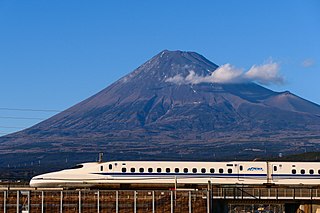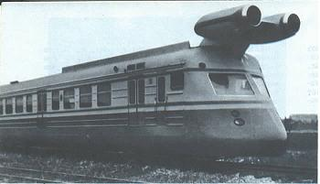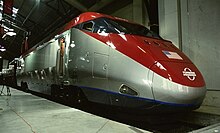
A locomotive or engine is a rail transport vehicle that provides the motive power for a train. If a locomotive is capable of carrying a payload, it is usually rather referred to as a multiple unit, motor coach, railcar or power car; the use of these self-propelled vehicles is increasingly common for passenger trains, but rare for freight.

High-speed rail (HSR) is a type of rail network utilizing trains that run significantly faster than those of traditional rail, using an integrated system of specialised rolling stock and dedicated tracks. While there is no single standard that applies worldwide, lines built to handle speeds above 250 km/h (155 mph) or upgraded lines in excess of 200 km/h (124 mph) are widely considered to be high-speed.

The TGV is France's intercity high-speed rail service, operated by SNCF. SNCF worked on a high-speed rail network from 1966 to 1974 and presented the project to President Georges Pompidou who approved it. Originally designed as turbotrains to be powered by gas turbines, TGV prototypes evolved into electric trains with the 1973 oil crisis. In 1976 the SNCF ordered 87 high-speed trains from Alstom. Following the inaugural service between Paris and Lyon in 1981 on the LGV Sud-Est, the network, centered on Paris, has expanded to connect major cities across France and in neighbouring countries on a combination of high-speed and conventional lines. The TGV network in France carries about 110 million passengers a year.

A tilting train is a train that has a mechanism enabling increased speed on regular rail tracks. As a train rounds a curve at speed, objects inside the train experience centrifugal force. This can cause packages to slide about or seated passengers to feel squashed by the outboard armrest, and standing passengers to lose their balance. Tilting trains are designed to counteract this by tilting the carriages towards the inside of the curve, thus compensating for the g-force. The train may be constructed such that inertial forces cause the tilting, or it may have a computer-controlled powered mechanism.

The Acela is Amtrak's flagship passenger train service along the Northeast Corridor (NEC) in the Northeastern United States between Washington, D.C. and Boston via 13 intermediate stops, including Baltimore, New York City and Philadelphia. Acela trains are the fastest in the Americas, reaching 150 miles per hour (240 km/h), but only over 49.9 miles (80.3 km) of the 457-mile (735 km) route.

The Advanced Passenger Train (APT) was a tilting high speed train developed by British Rail during the 1970s and early 1980s, for use on the West Coast Main Line (WCML). The WCML contained many curves, and the APT pioneered the concept of active tilting to address these, a feature that has since been copied on designs around the world. The experimental APT-E achieved a new British railway speed record on 10 August 1975 when it reached 152.3 miles per hour (245.1 km/h), only to be surpassed by the service prototype APT-P at 162.2 miles per hour (261.0 km/h) in December 1979.

A streamliner is a vehicle incorporating streamlining in a shape providing reduced air resistance. The term is applied to high-speed railway trainsets of the 1930s to 1950s, and to their successor "bullet trains". Less commonly, the term is applied to fully faired upright and recumbent bicycles. As part of the Streamline Moderne trend, the term was applied to passenger cars, trucks, and other types of light-, medium-, or heavy-duty vehicles, but now vehicle streamlining is so prevalent that it is not an outstanding characteristic. In land speed racing, it is a term applied to the long, slender, custom built, high-speed vehicles with enclosed wheels.

The Bombardier–Alstom HHP-8 is a type of twin-cab electric locomotive manufactured by a consortium of Bombardier Transportation and Alstom for Amtrak and MARC. The locomotive's electrical drive technology is directly derived from the SNCF BB 36000 manufactured by Alstom.

The LRC is a series of lightweight diesel-powered passenger trains that were used on short- to medium-distance inter-city service in the Canadian Provinces of Ontario and Quebec.

The Turbotrain was any of several French high-speed, gas turbine trains. The earliest Turbotrain entered service in 1967, for use on France's SNCF intercity lines. There were four versions in total, with the last exiting service in 2005, and it is the Turbotrain that made advances possible for the TGV.

A gas turbine locomotive is a type of railway locomotive in which the prime mover is a gas turbine. Several types of gas turbine locomotive have been developed, differing mainly in the means by which mechanical power is conveyed to the driving wheels (drivers). A gas turbine train typically consists of two power cars, and one or more intermediate passenger cars.

The world record for a conventional wheeled passenger train is held by France's TGV, set in 2007 when it reached 574.8 km/h (357.2 mph) on a 140 km (87 mi) section of track.

In rail transport, the expression power car may refer to either of two distinct types of rail vehicle:
The TGV is France's high-speed rail service. The idea of a high-speed train in France was born about twenty years before the first TGVs entered service. At that time, about 1960, a radical new concept was thought up; combining very high speeds and steep grades would allow a railway to follow the contours of existing terrain, like a gentle roller coaster. Instead of one or two percent grades which would be considered steep in normal applications, grades up to four percent would be feasible, thus allowing more flexible routing of new lines. Over the next several years, this very general idea gave rise to a variety of high speed transportation concepts, which tended to move away from conventional "wheel on rail" vehicles. Indeed, the French government at the time favoured more "modern" air-cushioned or maglev trains, such as Bertin's Aérotrain; Steel wheel on rail was considered a dead-end technology. Simultaneously, SNCF was trying to raise the speeds of conventional trains into the range 180 to 200 km/h for non-electrified sections, by using gas turbines for propulsion. Energy was reasonably cheap in those years, and gas turbines were a compact and efficient way to fulfil requirements for more power. Following on the TGS prototype in 1967, SNCF introduced gas turbine propulsion with the ETG turbotrains in Paris - Cherbourg service, in March 1970.

The UAC TurboTrain was an early high-speed, gas turbine train manufactured by United Aircraft that operated in Canada between 1968 and 1982 and in the United States between 1968 and 1976. Amtrak disposed of the trains in 1980. It was one of the first gas turbine-powered trains to enter service for passenger traffic, and was also one of the first tilting trains to enter service in North America.

Several plans have been proposed for high-speed rail in Canada, the only G7 country that does not have any high-speed rail. In the press and popular discussion, there have been two routes frequently proposed as suitable for a high-speed rail corridor: Edmonton to Calgary via Red Deer and Windsor to Quebec City via London, Kitchener-Waterloo, Toronto, Ottawa and Montreal.

A turbojet train is a train powered by turbojet engines. Like a jet aircraft, but unlike a gas turbine locomotive, the train is propelled by the jet thrust of the engines, rather than by its wheels. Only a handful of jet-powered trains have been built, for experimental research in high-speed rail.

Diesel multiple units and railcars are trains, usually with passenger accommodation, that do not require a locomotive. Railcars can be single cars, while in multiple units cars are marshalled together with a driving position either end. As of December 2010, 23 percent of the rail passenger cars used on Network Rail are part of a diesel multiple unit.

The first-generation Acela Express trainset is a unique set of vehicles used on the Acela, Amtrak's flagship high-speed service along the Northeast Corridor (NEC) in the Northeastern United States. When they debuted in 2000, the sets were the fastest in the Americas; reaching 150 mph (240 km/h) on 33.9 mi (54.6 km) of the route. They were built between 1998 and 2001 by a consortium of Alstom and Bombardier. Each set has two power cars derived from units that Alstom built for the TGV, and six passenger cars derived from the LRC that Bombardier built for Via Rail.



















